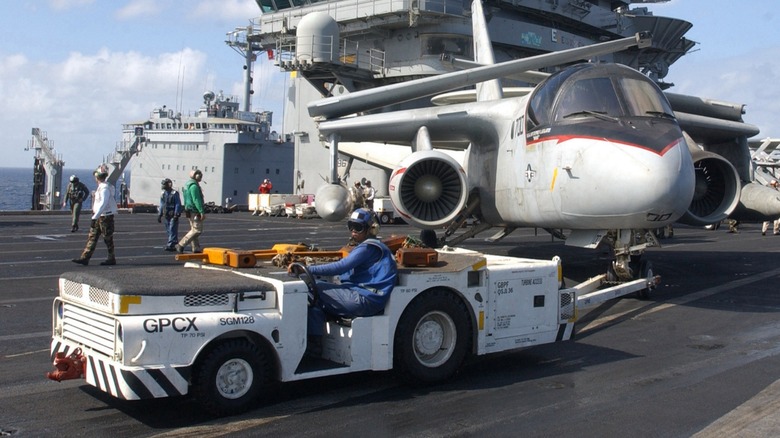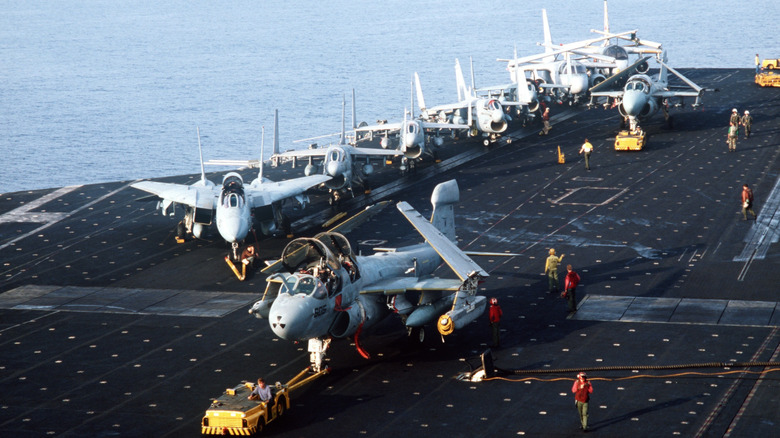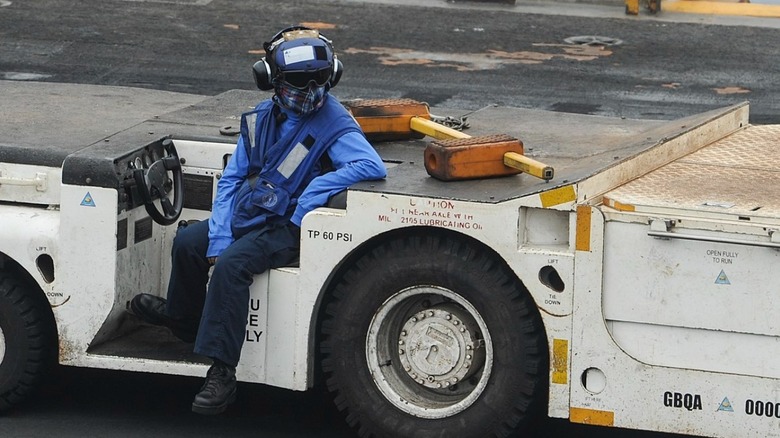What Are Tow Tractors And Why Do Aircraft Carriers Have Them?
Aircraft carriers, as the name would suggest, often host fighter jets and other military planes and helicopters. The need to accommodate such vehicles is also associated with some unique machines found aboard these huge vessels. One particularly interesting thing deployed on a carrier to meet these aircrafts' needs is the tow tractor. Different varieties of tow tractor are commonly seen in settings such as factories and distribution centers, where they can provide a convenient and efficient way for workers to carry especially heavy loads. Toyota's Large Tow Tractor, for instance, can carry a formidable load of 50,000 lbs. Considering that an F-16 Fighting Falcon weighs up to 37,500 lbs when ready to fly, and the F-22 Raptor weighs in at an astonishing 83,500 lbs, such a model could be up to the task, depending on the type of aircraft.
The role of these vehicles is to ferry the variety of aircraft aboard the gigantic vessel into position, into their associated hangar, or wherever they're needed.The issue with aircraft is that, while they can perform some remarkable feats of agility in the air (just watch a display team in action), they're generally very ungainly indeed down here on terra firma. There are various techniques that allow pilots to steer on the ground, but the impracticality of using their engines to simply load them onto a ship really limits them. So, too, does the simple lack of room for their large-scale maneuvering. As spacious as the deck of an aircraft carrier can be (the Gerald R. Ford class has 78 meter long flight decks), the same issue applies in this setting. This is why tow tractors are so important.
The hard, heavy work of a tow tractor
We can sometimes be guilty of marveling at the big-ticket items, without considering the supportive cast behind the scenes that helps make everything happen. Yes, fighter jets are wonders to behold as they streak through the air, but they wouldn't have made it there in the first place without a tow tractor. These are the workhorses that get these iconic aircraft across an aircraft hanger and into the sky.
The first thing you'll notice about these vehicles is that, of course, they're generally rather smaller than the vehicle they're designed to tow. Tug boats have a deceptive strength too, and it's a similar case with tow tractors. Oshkosh Aerotech, developer of the LEKTRO 87M tow tractor, notes that this particular model is specially created to transport military aircraft, and can tow those weighing as much as 85,000 lbs. The 89M, meanwhile, increases this capacity to 280,000 lbs. It's not just about having the brute force to tow such a model, but to be able to do so safely and securely too. The LEKTRO 87M is designed to be maneuverable, unobtrusive and low to the ground (so as not to be impeded in its duties by jutting aircraft components), and it boasts a universal nose gear lift cradle to protect landing gear. The fully-electric model doesn't require tow bars, and there are diesel models and hybrid options too. Hydraulic power is used in some models to 'carry' the aircraft by the wheels, and advanced features such as pintle connections allow for the towing of a variety of aircraft, like helicopters.
The jet engine Air Start Unit
The Naval Air Systems Command describes a particular variety utilized on aircraft carriers as a Shipboard Tow Tractor, or STT. It also has a vital additional duty of refueling the Air Start Unit used for the aircrafts' jet engines, and ferrying it to the planes in need. This is another crucial component of operations aboard an aircraft carrier. The Jet engine Air Start Unit on an aircraft carrier provides a means for the jets in question to get their engines started. In order to do this, it provides compressed air to the jet's engine. These engines can only start when a certain speed has been reached, and so this air is instrumental in providing that. It's connected to the aircraft (typically via length of tubing), starts its own operations, and then fuel is injected into the engine when the turbines are spinning fast enough. In this way, the speed increases further, until the engine is generating that speed independently.
Jet engines can develop enough suction power to potentially suck in a human, tragically, and it takes considerable effort to build up the kind of force they're capable of. An Air Start Unit isn't always necessary, because some aircraft boast their own Auxiliary Power Unit. Where this isn't the case, the Air Start Unit is, in essence, a portable version of such a component. The end result of all of this is that the tow tractor gets both the aircraft and, where needed, the start unit itself into position. Tow tractors look rather unassuming, designed to fit neatly and subtly around the powerful aircraft they support. Nonetheless, they can have a huge role to play in aviation operations.


